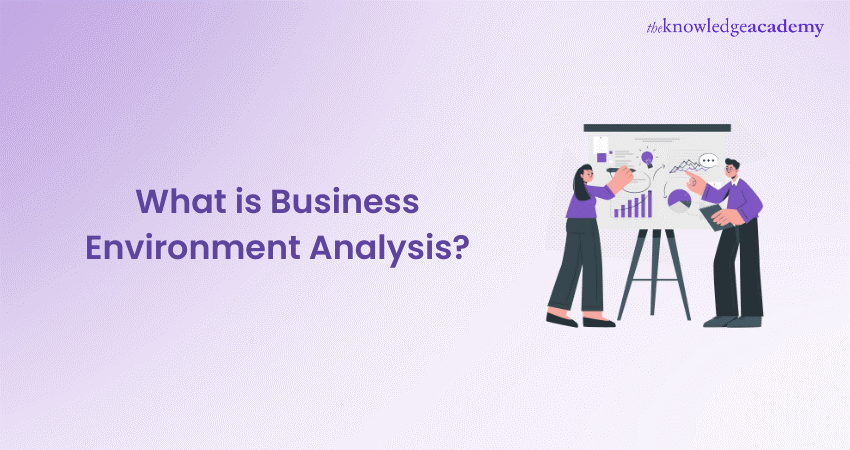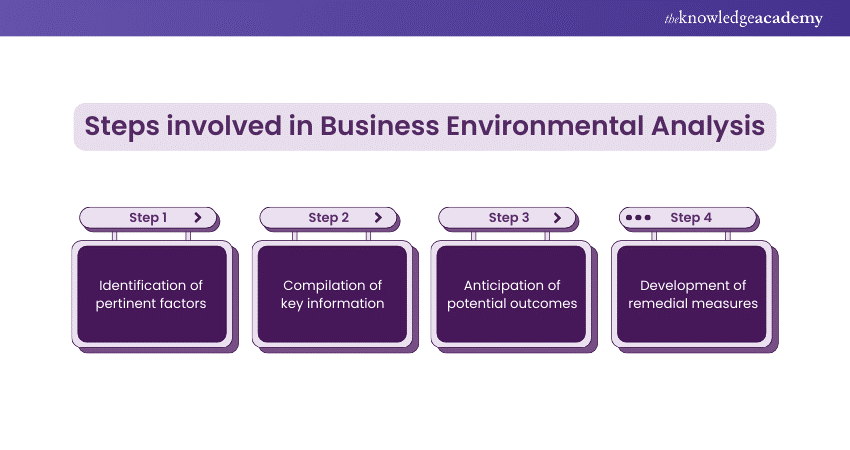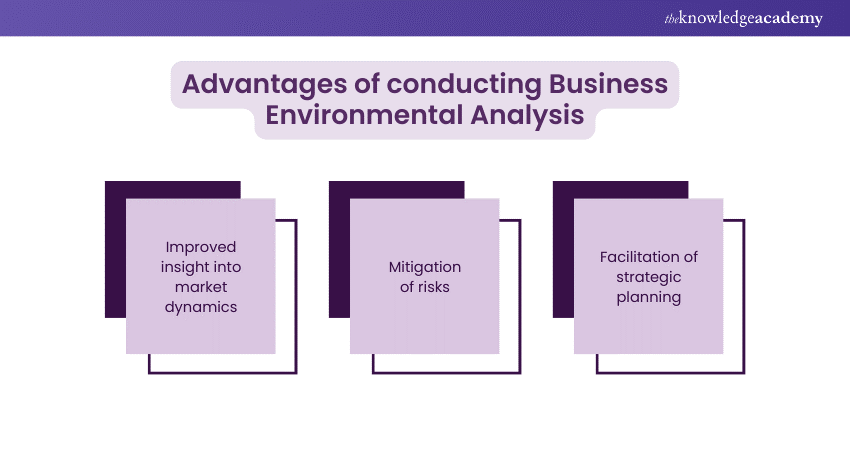We may not have the course you’re looking for. If you enquire or give us a call on 01344203999 and speak to our training experts, we may still be able to help with your training requirements.
Training Outcomes Within Your Budget!
We ensure quality, budget-alignment, and timely delivery by our expert instructors.

Business Environment Analysis is a systematic process for determining how a business can run effectively and achieve its targets. It involves identifying the different pillars affecting business performance, such as the economy, which helps shape society and politics, technological development, law, and the environment.
This results in pointing out the strengths and weaknesses of market situations and assisting in developing strategic and decision-making plans. Learning how to read the dynamics of the market is critical for businesses. Read this blog further to learn how Business Environment Analysis can help your business succeed by understanding the organisation's strengths and weaknesses.
Table of Contents
1) What is Business Environmental Analysis?
2) Importance of Business Environment Analysis
3) Purpose of Business Environmental Analysis
4) Types of Business Environment Analysis
5) Steps involved in Business Environmental Analysis
6) PESTLE Model of Business Environment Analysis
7) Advantages of conducting Business Environmental Analysis
8) Conclusion
What is Business Environmental Analysis?
Business Environmental Analysis is a strategic tool which helps companies know how external and internal environment factors influence their operations and performances. It, as a function, is used to examine things like economic trends, technological advancements, regulatory landscapes, competitive dynamics and social changes that can influence the business's ability to meet its objectives.
This analysis spotlights a company’s distinctive features, areas for improvement, market weak spots, and threats to the organisation. Such discoveries can help derive strategies that exploit strengths while eliminating weaknesses. It’s a preventive method that would guarantee the flexibility, competitiveness, and relevance of a business in a dynamic economy.
Importance of Business Environment Analysis
Business Environment Analysis is crucial to do business because it reflects the overall environment of an organisation clearly showing the company what it entails. It serves as a preventive and an innovative measure because it assists firms to foresee changes, recognise new tendencies, adjust to the emerging market trend and avoid possible risks.
By means of this analysis, companies can wind up how external factors affect their strategic objectives and operational planning. This allows them to perform well in the way they deploy resources.
It makes a business active, flexible, sustainable, and a powerful means of preparation for the unexpected and targeted dealing with fierce rivalry. Since the Analysis of the Business Environment forms the base for strategic planning, sustainable growth, and risk management of the business, it cannot be overlooked.
Purpose of Business Environmental Analysis
Let us now discuss the purpose of Business Environmental Analysis:
1) Recognising opportunities
Recognising business opportunities that may take longer to become noticeable is the primary goal of the Environmental Analysis of a Business. Through an in-depth analysis of market data such as trends, customer tastes, technology, and law, businesses can learn about opportunities for growth and innovation. This upfront movement makes companies leverage early opportunities to create a significant advantage and opens the chance for them to expand to new markets/segments for growth.
2) Managing threats
Identifying and managing potential risks is also an essential purpose of Business Environmental Analysis. External factors such as competitive responses, economic fluctuations, and changes in legislation create serious risks for the operations.
Through identifying these risks beforehand, enterprises may develop alternative plans, complement their product lines or modify their strategies to maintain continuity of their operations and profitability in the long run.
3) Crafting strategies
The insights delivered by Business Environmental Analysis are valuable for developing an intelligent and successful business strategy. Internal and external business environments understanding enables connecting company's strengths and weaknesses with the available opportunities and threats. This alignment is important for the setting of clear objectives, sound strategic decision making, and the allocation of resources wisely that can deliver intended results.
4) Strengthening competitive edge
Business Environmental Analysis is a major tool that helps a company increase its competitive advantage. Through an active and ongoing assessment of the wider business environment, companies will be able to stay ahead of emerging trends and needs of customers, innovate in response to changing factors and differentiate themselves from their competitors. Such successive series of adaptation to the changes is key to remaining relevant in the market and having a long-term competitive advantage.
Elevate your career with the BCS Advanced International Diploma in Business Analysis Course— register now to become a certified Business Analysis expert!
Types of Business Environment Analysis
These are the four different types of Business Environment Analysis; let’s have a close look at each one of them:
1) Internal environment
The Internal Environment Analysis encompasses considerations that could weaken the organisation to fulfil the customers' needs and its business objectives. This would entail an appraisal of the organisation's culture, sub-culture, physical resources, human resources, and technology.
The focus is to pinpoint factors within the organisation that could hinder its operational efficiency and progressive strategic orientation. Major elements usually scrutinised include the type of leadership, morale of employees, operating processes, and IT capabilities that will help them harness their strengths and rectify their weaknesses.
2) External environment
External Environment Analysis involves examining factors outside the company that could affect its performance and strategic options. This analysis is typically split into two further categories:
a) Microenvironment: A microenvironment is made up of those elements that influence business and are within the small circle of interests of the business, which can be the competitors, suppliers, distributors, and industry trends. Such an analysis allows companies to be aware of the existing competition, clients, and the market by studying the client's needs and preferences, as well as the supply chain dynamics.
b) Macro environment: Macro environment determines everything in society and is not limited to the organisation. This includes PESTEL factors: Political, Economic, Social, Technological, Environmental, and Legal framework. Understanding the factors, the organisation attains the ability to identify major trends and changes in the international business environment and thus, long-term strategy ability is provided.
Steps involved in Business Environmental Analysis
If you want to conduct a Business Environmental Analysis, then these are the steps that are involved:

Step 1: Identification of pertinent factors
The first step in this process is the identification of aspects that are directly responsible for shaping the organisation's growth process. Here, the team differentiates between the inner and the outside environment, addressing the micro and macro factors.
It requires a deep knowledge of that business, industry, and the whole economic and social context in which it operates. Identifying those determinants correctly is consequential for the next business process analysis and selecting the most powerful factors that impact the business.
Step 2: Compilation of key information
After the critical factors have been isolated, the next stage involves the collection of information pertinent to these factors. The focus in this case is on the collection of data on market tendencies, competition strategies, regulatory changes, technology innovations and socio-economic conditions, to mention but a few.
The exercise aims to compile exhaustive and fresh information to serve as a base for further analysis. This step typically involves information from multiple sources, such as market studies, industry reports, financial documents, and legal papers.
Step 3: Anticipation of potential outcomes
Of utmost importance is decision-making with the help of the existing and anticipated current and forecasted environment. This includes examining the collected data to forecast how the identified factors will be modified and what kind of consequences the changes could be.
Scenarios planning can be useful in the frame, helping entrepreneurs to investigate possible scenarios and then make a connection among different elements in complex ways. The aim is to envisage possibilities and hazards that could be derived from the ever-changing business environment.
Step 4: Development of remedial measures
The final level is to develop the remedial measures, or the decision-making strategies based on the expected results. It refers to the construction of strategies which benefit from the insights obtained through the analysis, minimise the risks identified and support the overall objectives.
a) Diversifying product lines
b) Entering new markets
c) Adjusting marketing strategies
d) Investing in new technologies
e) Altering operational processes
The key is to formulate flexible and resilient strategies that enable the organisation to effectively adapt to changes in the business environment.
Unlock the power of agility in business- join now for our BCS Foundation Certificate in Agile Course!
PESTLE model of Business Environment Analysis
The PESTLE model is a comprehensive business framework used to analyse the external macro-environment that impacts an organisation's operations. It examines the following six key dimensions:
Political
The Political side looks into the part where government policies can affect business operations. Instability of government, for example, in a country or its tax policies and labour laws can be detrimental to a business. Trade restrictions can also affect a business's operation.
This dimension is very significant for establishing the ways in which political decision-making and changes in legislative structure deteriorate the business environment, operational ability and strategic decisions of businesses.
Economic
On an economic dimension, an organisation looks into the economic factors that might be influencing its profitability. Such types of fluctuations can be noted in interest rates, exchange rates, inflation rates, economic growth dynamics, unemployment indices, and fiscal policy mechanisms.
Reading the indicators which are present within the economic environment helps business foresee the possible developments, plan their budgeting and strategic evolution to avoid being misled into making wrong decisions on expansion, putting a price on their product and controlling the costs.
Social
Social situations are related to demographic shifts, cultural practices, lifestyle characteristics and persons attitudes towards a particular product or services. This component gives firms a good perception of the social background in which they operate to ensure that they can fine-tune goods and services, as well as market strategies, in line with changing needs and preferences of their targeted market.
Technological
The tech components include the speed of technology change, technology implementation, the advancement of technologies, R&D activities, and automation. Examining this element shows us the constant search for new technological opportunities, careful consideration of how the technologies affect operations, and finally, responding to the developing technologies by increasing efficiency and offering new products to the customers.
Legal
The legal dimension is typically looking at how laws and regulatory impact the conduct of the business. This is more in employment laws, health and safety act, consumer protection law, and environment regulation. Having the legal environment in mind is essential as businesses first establish compliance, minimise legal risks, and investigate the business-specific legal system in the host country.
Environmental
Environmental factors cover the effect of the physical environment and climate change on business operations. Such regulations include ecological requirements, sustainable operation, and the people’s recognition towards environmental issues like no waste issues.
Companies, on the other hand, assess this dimension to create an environmentally sustainable culture in their business settings, adapt to environmental challenges, comply with regulations, and integrate sustainability into their operational and corporate social responsibility strategies.
Advance your skills in delivering value and ensuring success – register now for our BCS Practitioner Certificate in Benefits Management and Business Acceptance Course!
Advantages of conducting Business Environmental Analysis
Conducting a Business environmental analysis offers significant advantages to businesses by providing a clearer understanding of the market dynamics, helping to mitigate risks, and facilitating strategic planning:

Improved insight into market dynamics
Business Environmental analysis enhances understanding of market dynamics, enabling businesses to detect trends, consumer needs, and competitive actions. This knowledge supports product development, market positioning, and competitive anticipation, which are vital for relevance and success in evolving markets.
Mitigation of risks
Business may find out, and manage operational, financial and growth risks by analysing the external environment it is working in. Firms can implement resistive methods such as aforementioned understanding of the risks from regulations, competition, and socio-economic shifts, and facilitating the acceptance of volatility in their organisation.
Facilitation of strategic planning
The core of strategic planning lies in environmental analysis, that is, data-driven facts for better-informed decisions. It guides businesses to link strengths to opportunities and resolve weaknesses, such that strategic goals are pertinent, resources are optimally allocated, and the company is dynamic to changes in markets.
Conclusion
We hope this blog has helped you understand the importance of Business Environment Analysis and why every organisation must conduct this process. Through this process, organisations can figure out their strengths and weaknesses, which can help them progress towards success.
Drive transformative change effectively—register for the BCS Foundation Certificate in Business Change Course today!
Frequently Asked Questions

Factors affecting the Business Environment include economic conditions, political and legal frameworks, technological advancements, social and cultural trends, and environmental concerns.

Analysing the business environment is crucial for identifying opportunities and threats, understanding market dynamics, and making informed strategic decisions. It enables businesses to adapt to changes, capitalise on emerging trends, and maintain competitiveness in a rapidly evolving marketplace.

The Knowledge Academy offers various Business Analysis Courses, including BCS Certificate in Business Analysis Practice Course, BCS Practitioner Certificate in Requirements Engineering Course, and BCS Practitioner Certificate in Modelling Business Processes Training. These courses cater to different skill levels, providing comprehensive insights into Business Analysis.
Our Business Analysis blog covers a range of topics related to Business Analysis, offering valuable resources, best practices, and industry insights. Whether you are a beginner or looking to advance your Business Analysis skills, The Knowledge Academy's diverse courses and informative blogs have you covered.

The Knowledge Academy’s Knowledge Pass, a prepaid voucher, adds another layer of flexibility, allowing course bookings over a 12-month period. Join us on a journey where education knows no bounds.

The Knowledge Academy takes global learning to new heights, offering over 30,000 online courses across 490+ locations in 220 countries. This expansive reach ensures accessibility and convenience for learners worldwide.
Alongside our diverse Online Course Catalogue, encompassing 17 major categories, we go the extra mile by providing a plethora of free educational Online Resources like News updates, Blogs, videos, webinars, and interview questions. Tailoring learning experiences further, professionals can maximise value with customisable Course Bundles of TKA.
Upcoming Business Analysis Resources Batches & Dates
Date
 BCS Practitioner Certificate in Modelling Business Processes Training
BCS Practitioner Certificate in Modelling Business Processes Training







 Top Rated Course
Top Rated Course



 If you wish to make any changes to your course, please
If you wish to make any changes to your course, please


